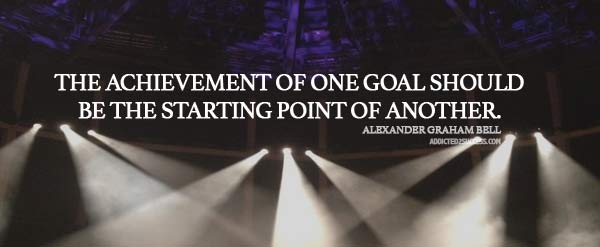Success Advice
The Art Of Platforming – Using One Achievement To Reach Another
You are probably well aware of your best bowling score, dance move, marathon time, or pick-up line; however, you should know something about the call for perseverance, practice, patience, and vision as well. Those attributes helped you to achieve whatever you wanted to accomplish.
However, in order to achieve what we dream of, we must use one achievement to reach another.
How To Platform Your Way To Success
There are a number of essentials at work. Looking back at past achievements to decipher ways to reach new ones gives us the confidence to go forward and attain our next objective. As we reach one plateau after another, the will becomes stronger and our goals become more realizable. For example, successful leaders have frequently built a successful career by taking their achievements from their previous company and building on them in another.
In fact, climbing up the ladder or achievement building is quite common. Especially when building a company or individual brand. For example, famous rapper 50cent is a perfect example of using one achievement to reach another. He personifies the concept of starting from nothing and using each of his experiences as a stepping-stone to become a winner. Not only materially but in the heart as well.
1. Using Achievement Successfully
An individual coming from nothing and building an empire is exactly how building upon achievements work. Of course, you must have the vision and the will to accomplish. In addition, you don’t have to build an empire either. Building upon achievements can be as simple as starting out in a company and taking that experience to another company or within the same company.
The days when the CEO of a company started off in the mailroom seems to be long gone. However, those successes are what “achievement building” is all about. A fresh kid out of college, or in times gone by, only out of high school, took a job in a large company, perhaps being a “gofer” as they were called back in the day. They worked diligently and in two years, they are promoted to an office job. After a few more years, the company puts them in a special training class and the individual is promoted to assistant manager. After a few years of being an assistant manager, he/she is promoted to director and the achievement building continues until they reach CEO. However, you must have a vision of where you want to go or you will never get there.
Successful leaders frequently built a rewarding career by taking their achievements from one corporation and building on them in another. Either by a decision on their own, or from being recruited, these leaders frequently carry learning and perceptiveness from one experience and use it for another, with fantastic results.
2. Achievement and Outlook
Studies show that there are two varying kinds of achievement-associated attitudes. They are ego-involvement and task-involvement. Task-involvement is the stimulated phase where a person’s chief objective is to obtain proficiency and understanding. Ego-involvement is mainly to exhibit advanced abilities. One example of a pursuit where an individual endeavors to attain mastery and display advanced ability is when learning a skill. Nonetheless, an individual’s environment and surroundings can influence the triumph of achieving an aspiration at anytime.
Achievement can take various structures. It can be a mundane act such as getting the laundry done that’s been sitting for ages, finishing a puzzle, starting and finishing a diet, or beginning a new career. In addition, purpose shows that achievement is actually capricious and means something different to each individual. What may be an important achievement for one individual is a piece of cake to another. On the whole, achievement is whatever gives a person a sense of self-respect in a personal action or attained knowledge, regardless of its simplicity.
It is whatever makes an individual feel noble and whatever solidifies their competence to themselves. In addition, each gain builds confidence and motivates the individual to build on that confidence. Achieving is about having your desires satisfied, reinforcing your confidence, and boosting your sense of worth. In fact, the need to achieve is innate in each of us. Whether we take advantage of it is another story. Lack of confidence, negative thoughts, and a feeling of unworthiness creates a void. This void creates a lack of initiative and cannot be filled until the individual takes action. Afterwards, a well-rounded person is the result. One who feels worthy of achievement.
Consistent failure to achieve what we want thwarts confidence, making a person feel inadequate. It sets us up for failure and questions the significance of what we are doing. Therefore, while working on our achievements, and even before, we must convince ourselves that our efforts are worthwhile, that we are worthy of success.

3. Achievement and Faith
While on the road to achievement things may not always go as planned. If we feel the desire to “prove ourselves,” and things do not go as planned, this may lead many individuals to throw in the towel. Having an open mind is vital. As one great philosopher stated “everything may look like its going wrong, and it’s going right.” Achievement is built on faith in our abilities. Therefore, in order to build on one achievement after another, we must also build our faith.
In fact, what many call a “lack of confidence” is really a “lack of faith.” Continuously looking over our shoulders to see what the next person is doing to validate our worthiness, is a prerequisite to doubt our abilities to achieve what we set out to do. Living in the “now” is a perfect remedy for doubt and lack of confidence, and many times, it is our habit of “looking too far in the future,” that prevents us from working on what we can achieve “right now.”
4. Creating Your Own Opportunities Through Achievement
It is up to each person to develop their potential and create their own opportunities. Taking the initiative to “jump and catch our wings on the way down,” is a scary thought. However, that’s pretty much how it goes. The step forward is the leap into the unknown. As one great thinker said:
“boldness has magic in it.”
However, we should not confuse boldness with foolishness. A bold person has taken considerable thought into their next move. Even with a bit of doubt, they are willing to take the risk. A fool gives no forethought to their actions. They repeatedly repeat the same action expecting a different result each time. A lemon pie will not turn into a pumpkin pie, unless you change the ingredients.
Regardless of a person’s qualifications, a feeling of inadequacy to achieve can wipe out confidence and impede potential. By constantly looking to others to create our opportunities for success we undermine our part in its fruition. Many people are good at creating success for others; however, this scheme falls short when it comes time to create that success for themselves.
5. Achieving Your Best
By putting their best foot forward, a person can achieve the best out of life.
First of all, becoming a better individual allows you to take hold of your new experiences and abilities; therefore, manifesting a more harmonious life. Consider how your life is different than it was five years ago.
Have you achieved what you set out to do? Does your life have more clarity, perspective and depth than yesterday?
What may have been a straightforward day-to-day occurrence previously, has more importance to the new you today. In other words, looking back with wisdom, you see why certain things happened the way they did. If you can do this, it is an indication of true growth and achievement.
Change Your Mindset
The Silent Skill That Makes People Respect You Instantly
What truly earns respect and why most people go about it the wrong way

Everybody craves respect but not everyone earns it. Some people believe that a title, years of experience, or a position of authority automatically entitles them to respect. (more…)
Entrepreneurs
The Essential Skills Every Entrepreneur Needs In 2026
Success in the digital age isn’t about luck. It’s about mastering the skills that separate dreamers from doers.

When I was 22 years old, I started my first side hustle as a ghostwriter. (more…)
Did You Know
The Success Patterns You Inherited (And Didn’t Notice)
Your family history may hold the key to why you think, act, and feel the way you do today.

Who are you? Your experiences and your family’s narratives and legacies contribute to your identity. Your ancestry contains individual traits and forces that have been inherited over the years. It also carries the fights and victories of your forebears and older family members. (more…)
Shift Your Mindset
11 E’s That Define Every Great Leader And Why Most People Miss Them
If you’ve ever felt the pull to lead, this is your roadmap to turning inner potential into lasting influence.

What Is Leadership, Really?
Leadership is far more than a title or position. It’s the ability to envision a future, inspire others, and align people toward a shared goal. (more…)
-

 Success Advice4 weeks ago
Success Advice4 weeks agoInside the TikTok Resume Hack That’s Fooling Recruiters (For Now)
-

 Change Your Mindset4 weeks ago
Change Your Mindset4 weeks agoThe One Leadership Habit That Separates the Great From the Forgettable
-

 Personal Development3 weeks ago
Personal Development3 weeks agoThis Silent Habit Might Be Sabotaging Your Career
-

 Business3 weeks ago
Business3 weeks agoWhy Your E-Commerce Fulfilment Is Probably Broken (And How to Fix It)
-

 Shift Your Mindset2 weeks ago
Shift Your Mindset2 weeks ago11 E’s That Define Every Great Leader And Why Most People Miss Them
-

 Did You Know2 weeks ago
Did You Know2 weeks agoThe Success Patterns You Inherited (And Didn’t Notice)
-

 Business2 weeks ago
Business2 weeks agoThe Hidden Money Pit in Your Operations (and How to Use It)
-

 Entrepreneurs1 week ago
Entrepreneurs1 week agoThe Essential Skills Every Entrepreneur Needs In 2026



























1 Comment